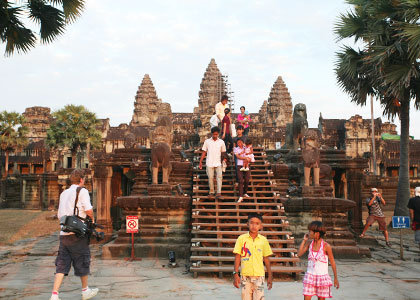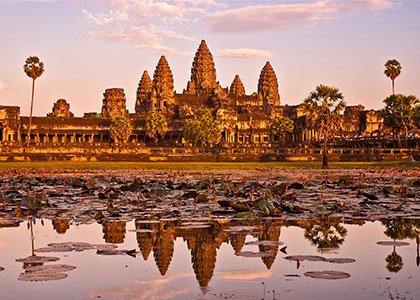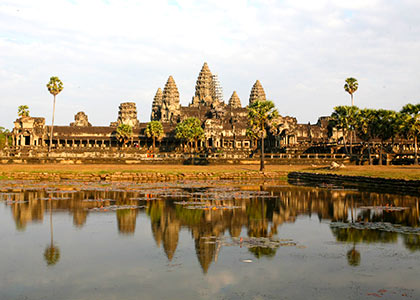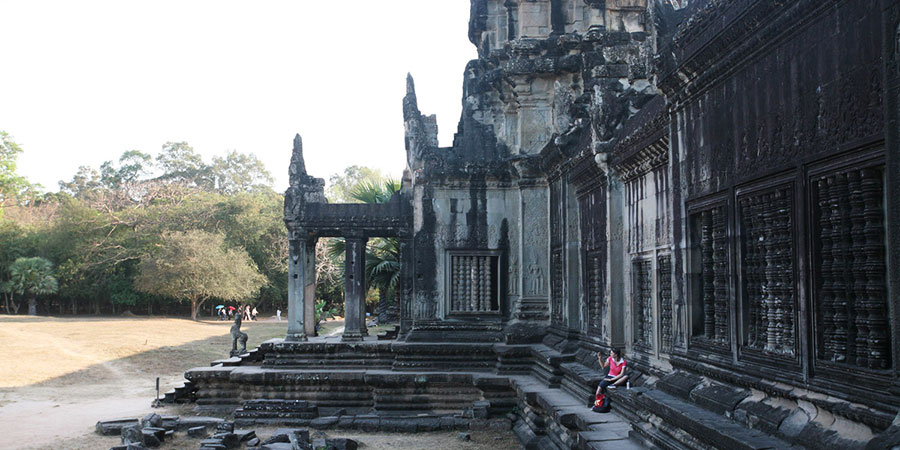How to Visit Angkor Wat
One of the world’s most famous temple complexes, Angkor Wat was once a city; the proud capital of the Angkor Kingdom. Today, the temple complex plays host to more than a million international tourists each year. If what you have read about Angkor Wat has got your attention, then read on to know all about how to visit Angkor Wat and prices of Angkor Wat tickets.Exploring Angkor Wat the Right Way
An expedition through this huge 400 acre architectural landscape may become cumbersome without a strategic plan. The unsympathetic sun, unbearable humidity, impatient crowd and the phenomenon called ‘temple fatigue’ may deprive you from some of the top highlights. Some good recommendations to help you plan better include:• Buy at least a 3-day pass and utilize it for exploring the complex over 4-5 days (Yes! You don’t essentially need to use the pass for 3 consecutive days)
• Know the major highlights of the complex and keep your expedition restricted to them. You may easily discard some of the temples that may appear monotonous
• In order to avoid crowd, follow a route to visit the less-crowded attractions in the beginning (more about it later).
Start with the Magical Sunset and Sunrise Vistas
Watching sun as it embarks on its day-long journey across the sky while rising behind the breathtaking edifices of the main Angkor Wat Temple is nothing less than a visual treat. Equally overwhelming is the spectacle of sun burying into the lush green forest in the evening. Angkor Wat sunrise and sunset are probably the best experiences of the entire trip. So, how to plan for them?
|
|
|
The first idea is to buy your Angkor Wat tickets after 05:00 p.m. By doing so, you would be able to access the park for free the same evening while keeping the ‘pass-days’ unutilized. If that’s not possible, plan to witness sunset on the first day and sunrise the next day. Angkor Wat sunset happens between 05:15 p.m. and 06:00 p.m. and appears marvelous from all points across the complex.
The real deal is to get ready for the sunrise. It is recommended to be there around 04:30 a.m. as the right spot to watch the rising sun may get over-crowded in no time. Pack your breakfast and plan to have it after you watch the sunrise. The area in front of the lake facing the main Angkor Wat Temple is the perfect spot for the activity. For a better experience, follow these tips:
• Stand closest to the lake. If you leave even a foot of a space, someone else might stand in front of you.
• Find someone shorter in height and occupy the spot behind him or her.
• Don’t forget to carry a flashlight as it may be dark before the dawn and the crowd may become difficult to navigate through.
Best Places to Watch Sunrise & Sunset Views: Phnom Bakheng Pre Rup Temple
Exploring the Temples
Plan to visit the Angkor Wat and then the nearby temple of Angkor Thom on the first day. Exploring these two massive temples may leave you enchanted as well as overwhelmed enough for the whole day. The exotic carvings, old inscriptions and soaring towers of these temples are like mysteries engraved on stone. The Bayon is the topmost highlight of Angkor Thom, as it features numerous smiling stone faces and bas-reliefs flaunting the mythological and historical scenes.

Ta Prohm Temple
|
• Ta Prohm and Ta Som: One of the best places you would ever come across, the temple ruins have trees growing out of them in an artistic manner.
• Banteay Srei: Admired for its decorations in pink sandstone.
• Elephant Terrace: Features huge carvings of elephants, lions and garudas.
• Preah Khan: Believed to be a huge Buddhist University with the capacity of accommodating thousands of teachers and students.
• Others: Srah Srang (royal baths), Terrace of the Leper King, Pre Rup and East Mebon.
See More: What to See inside Angkor Wat?
Useful Tips
• Experiencing Angkor Wat in a day is difficult, as the complex is so big. Therefore, we would recommend a single-day pass to you only if you have one day in hand to visit Angkor Wat.• If you want to take your time with your Angkor Wat explorations, then the three-day or seven-day pass would suit you better.
• Remember to keep your pass with you securely, as security staff may ask you to show it randomly while you are inside.
• If you can’t furnish your pass to security officials, you will just give them an excuse to rip you off.
• Beware of mosquitoes and carry mosquito repellants and other protections.
• Monkeys may cause chaos. Don’t feed them and keep your belongings safe.
• Carry enough water, hat, sunscreen etc. to fight the daunting sun and heat.
• Don’t get inside the sacred lakes called Barays.
• Children under 12 might not be allowed inside few temples.
• Be respectful in dressing up, Avoid clothes that reveal knees and shoulders.
• Communicate with your tuk-tuk driver about the place from where he would pick you up. As there are multiple entry and exit points to each temple, there are chances that you may face difficulty meeting the driver.
Best Time to Visit Angkor Wat
Cambodia stays open to tourists and travelers throughout the year. So you can visit Angkor Wat at any time of the year.• Winters (November – February): The winter months are the months during which Cambodia stays the most crowded with calm and pleasant weathers.
• Summers (March –June): The soaring temperatures and the excessive humidity may be turn-offs for those who want to visit Angkor Wat in the summers, as the summer months are considered off-season.
• Monsoons (July –October): The incessant rains make travelling difficult, as Cambodia witnesses more than 20 days of rain every month during the monsoon season.

Crowds Visit Angkor Wat in winter
|
The best time to visit the complex is from the sunrise till 11:00 p.m. if it is an extremely hot day. During winters, you may utilize the whole duration for which the complex stays open.
Angkor Wat Tickets
You can pay the Angkor Wat entrance fee by either cash or credit card. American Express credit card users, however, can only pay through cash as American Express cards are not accepted here.• Single-day pass: USD37
• Three-days pass: USD62
• Seven-days pass: USD72
You can buy the passes for entering the Angkor Archaeological Park at the ticket counter in front of the entry gate. There are toilet facilities near the counter as well, along with some food stalls serving local Khmer delicacies. There are 25 ticket windows; still it may take time to get the ticket. Make sure you carry your passport as it may be required.
How to reach Angkor Wat?
Before you worry about paying up the Angkor Wat entrance fee, you need to reach the city of Siem Reap; one of Cambodia’s biggest cities and the gateway to the Angkor Wat tickets counter, along with the temple complex.From the airport, you have to take a taxi to reach the Siem Reap city center, which is 5.5 km (3.4 miles) away.
Once you reach Siem Reap, you can finally turn your attention towards Angkor Wat tickets. The journey from Siem Reap to Angkor Wat is a short one and you can easily get taxis, tuk-tuks as well as bicycles and motorbikes on rent. Bicycles may be adventurous but daunting due to hot sun and humidity, while tuk-tuks are cheap and convenient. You would pay the rental fee $20-30 per day on the cab, $8-12 a day on a tuk-tuk or e-bike.
As the Angkor Wat complex is over 400 acres in terms of the area it occupies, we would recommend you to hold on to the tuk-tuk or taxi after you pay the Angkor Wat entrance fee. Local drivers have great knowhow on all the sights to behold and spectacles to visit within the complex.
With so much said, we hope you take the time out to travel to Cambodia and experience a UNESCO World Heritage Site that never fails to amaze and inspire.
Read More: Why Was Angkor Wat Abandoned? Who Built Angkor Wat?










